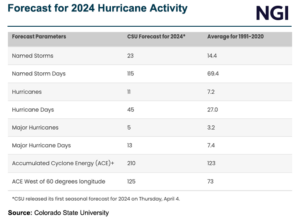August Natural Gas Futures Fail to Find Footing amid Sustained Heat, Containment Concerns
Persistent concerns about coronavirus fallout, weak liquefied natural gas (LNG) exports and potentially premature production increases weighed on markets Friday, outshining optimism about strong cooling demand. The August Nymex contract fell a half-cent day/day and settled at $1.718/MMBtu. September fell 1.1 cents to $1.765.

NGI’s Spot Gas National Avg. rose a half-cent to at $1.685.
“Weather remains bullish in terms of a sustained hotter-than-normal pattern, which we feel continues on into August,” Bespoke Weather Services said Friday. “The heat continues to lack extremes as far as any one region is concerned, but the persistence and aerial coverage of above-normal temperatures keeps us on pace to rival July 2011 for the highest July” on record in terms of gas-weighted degree days. “The next week to 10 days, in absolute terms, look to be the peak of our summer heat, nationally.”
Intense July heat proved the undercurrent for a modestly bullish storage report Thursday.
The U.S. Energy Information Administration (EIA) reported an injection of 45 Bcf natural gas storage for the week ending July 10, the third consecutive week of sub-100 builds. The average of major polls had landed at 47 Bcf prior to the report. The latest injection figure compared with a 67 Bcf storage build in the same week in 2019 and a five-year average injection of 63 Bcf.
Analysts viewed the result as confirmation that the lofty July temperatures were helping to address imbalances created by the coronavirus pandemic.
EBW Analytics Group said the most recent data imply “a bullish 0.5 Bcf/d tightening in the underlying supply/demand balance relative to late June/early July levels.”
That noted, the firm said balance trends are highly dependent on robust cooling demand, and near-term prices are likely wed to continued forecasts for above-normal temperatures.
The pandemic, however, remains a glaring wild card. Cases of the virus are surging globally and in the Lower 48 – the United State recorded a single day record on Thursday – threatening commercial and industrial energy demand domestically as well as demand for U.S. LNG exports to Europe and Asia. Exports already are well below pre-pandemic levels, and cargo cancellations have become commonplace as the virus persists.
EIA reported in its latest Short-Term Energy Outlook that 110 U.S. cargoes were canceled for June-August lifting.
The looming question is, will recent tightening “relapse amid widespread stay-at-home behavior in key gas demand markets or a step-down in federal economic assistance over the next month — potentially yielding a parallel decline in natural gas futures?” EBW said.
On the positive side, U.S. pipeline gas exports to Mexico reached a new high of 6.45 Bcf on Wednesday, driven by increasing power burns as the Mexican economy emerges from the grips of the virus and energy demand increases.
The specter of continued virus outbreaks and economic disruption elsewhere, however, raises concerns that LNG demand may not pick up where summer heat leaves off and that containment challenges loom in the fall. The most recent storage injection boosted inventories to 3,178 Bcf, up from the year-earlier level of 2,515 Bcf.
Genscape Inc. estimates show a bumpy ride for LNG in July, though mostly along a low level relative to pre-pandemic norms. The firm said volumes dropped 1.1 Bcf/d on July 1, down from 4.2 Bcf/d to 3.1 Bcf/d.
“Since then, LNG feed gas demand has remained depressed, averaging only 3.1 Bcf/d since the start of the month,” Genscape analyst Preston Fussee-Durham said. Genscape’s estimate for Friday’s LNG demand was up from the average at 3.41 Bcf/d, the analyst said, yet still weak.
At the same time, production has increased as oil drillers reopen wells and produce associated gas, amplifying the worry that containment issues could emerge without some recovery in LNG demand, Bespoke noted.
“The market is clearly concerned about containment,” the firm said. But power burns “remain solid in absolute terms” and, “assuming our expectation for above-normal heat continuing into August is correct, we still feel that containment ultimately will be avoided this fall.”
Spot Prices
Cash prices advanced in several regions, buoyed by heat waves.
“Strong heat with highs of upper 90s to 110 continues from California to Texas, while hot and humid with highs of mid-90s over the South and Southeast for strong demand,” NatGasWeather said. “Hot high pressure will expand to include the Great Lakes and Northeast” for several days with highs of 90s stretching from Chicago to New York City, while also heating up across the Northwest with upper 80s and 90s to aid national demand.
The only cooler exceptions are across the Northern Plains and New England, the forecaster said, as weather systems lead to highs of 70s to 80s. However, hot upper high pressure is expected to “rule much of the United State July 21-30 with widespread upper 80s to 100s. A hot versus normal pattern is expected into the start of August with widespread heat and humidity for strong national demand.”
Big gainers included Algonquin Citygate, up 35.0 cents day/day to average $1.820, and PNGTS, ahead 58.0 cents to $3.055, as well as Tenn Zone 6 200L, up 37.0 cents to $1.870. All are in the Northeast. In Appalachia, Texas Eastern M-3, Delivery jumped 38.5 cents to $1.930.
Concerns earlier in the week about supply in the regions on Texas Eastern Transmission (Tetco) eased. Tetco on Monday gave notice that capacities would be reduced on its 30-inch diameter line over most of the remainder of July.
Declines on Friday were most pronounced in California, where SoCal Citygate lost 10.0 cents to $1.845
In pipeline news, Williams said on Friday that it received approval from the Federal Energy Regulatory Commission to move forward with its Leidy South project, which the Tulsa, OK-based company expects would create 582,400 Dth/d of additional pipeline capacity and enable more power plants to convert from coal to natural gas.
The project is to connect supplies of natural gas produced by Cabot Oil & Gas Corp. and Seneca Resources Co. LLC in the Marcellus and Utica regions of Pennsylvania with demand markets along the Atlantic Seaboard by the 2021-2022 winter heating season.
© 2024 Natural Gas Intelligence. All rights reserved.
ISSN © 1532-1231 | ISSN © 2577-9877 |


